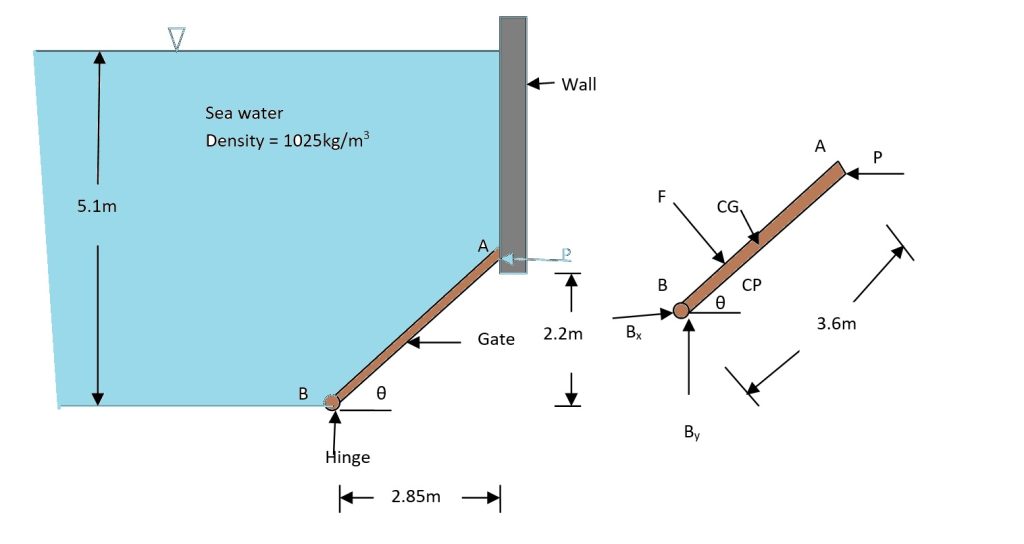Problem Statement
Determine the length of the back water curve caused by an afflux of 1.5 m in a rectangular channel of width 50 m and depth 2.0 m. The slope of the bed is given as 1 in 2000. Take Manning's, N = 0.03.
Given Data & Constants
- Channel width, \(B = 50 \, \text{m}\)
- Normal depth, \(d_n = 2.0 \, \text{m}\)
- Afflux = 1.5 m
- Maximum depth at obstruction, \(d_{max} = 2.0 + 1.5 = 3.5 \, \text{m}\)
- Bed slope, \(S_0 = 1 \text{ in } 2000 = 0.0005\)
- Manning's roughness coefficient, \(N = 0.03\)
- Acceleration due to gravity, \(g = 9.81 \, \text{m/s}^2\)
Solution
1. Calculate the Discharge (Q)
First, we find the discharge under normal flow conditions using Manning's formula.
$$ A_n = B \times d_n = 50 \times 2 = 100 \, \text{m}^2 $$
$$ P_n = B + 2d_n = 50 + 2(2) = 54 \, \text{m} $$
$$ m_n = \frac{A_n}{P_n} = \frac{100}{54} \approx 1.852 \, \text{m} $$
$$ Q = A_n \times \frac{1}{N} m_n^{2/3} S_0^{1/2} = 100 \times \frac{1}{0.03} (1.852)^{2/3} (0.0005)^{1/2} \approx 112.1 \, \text{m}^3/\text{s} $$
2. Apply the Direct Step Method
We divide the backwater curve into segments and calculate the length of each. The total length is the sum of these segments. Let's use three steps for better accuracy.
| Depth (d) [m] | Area (A) [m²] | Hyd. Radius (m) [m] | Velocity (V) [m/s] | Spec. Energy (E) [m] | Friction Slope (S_f) |
|---|---|---|---|---|---|
| 3.50 | 175.0 | 3.070 | 0.641 | 3.521 | 0.000083 |
| 3.00 | 150.0 | 2.679 | 0.747 | 3.028 | 0.000135 |
| 2.50 | 125.0 | 2.273 | 0.897 | 2.541 | 0.000236 |
| 2.00 | 100.0 | 1.852 | 1.121 | 2.064 | 0.000500 |
Step 1: Length from d=3.5 m to d=3.0 m
$$ \Delta E_1 = 3.028 - 3.521 = -0.493 \, \text{m} $$
$$ S_{f,avg1} = \frac{0.000083 + 0.000135}{2} = 0.000109 $$
$$ \Delta x_1 = \frac{\Delta E_1}{S_0 - S_{f,avg1}} = \frac{-0.493}{0.0005 - 0.000109} = \frac{-0.493}{0.000391} \approx -1260.9 \, \text{m} $$
Step 2: Length from d=3.0 m to d=2.5 m
$$ \Delta E_2 = 2.541 - 3.028 = -0.487 \, \text{m} $$
$$ S_{f,avg2} = \frac{0.000135 + 0.000236}{2} = 0.0001855 $$
$$ \Delta x_2 = \frac{\Delta E_2}{S_0 - S_{f,avg2}} = \frac{-0.487}{0.0005 - 0.0001855} = \frac{-0.487}{0.0003145} \approx -1548.5 \, \text{m} $$
Step 3: Length from d=2.5 m to d=2.0 m
$$ \Delta E_3 = 2.064 - 2.541 = -0.477 \, \text{m} $$
$$ S_{f,avg3} = \frac{0.000236 + 0.000500}{2} = 0.000368 $$
$$ \Delta x_3 = \frac{\Delta E_3}{S_0 - S_{f,avg3}} = \frac{-0.477}{0.0005 - 0.000368} = \frac{-0.477}{0.000132} \approx -3613.6 \, \text{m} $$
3. Total Length of Backwater Curve
$$ L = |\Delta x_1| + |\Delta x_2| + |\Delta x_3| = 1260.9 + 1548.5 + 3613.6 = 6423 \, \text{m} $$
Final Result:
The total length of the back water curve is approximately 6423 m or 6.42 km.




